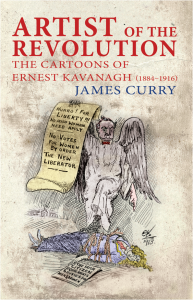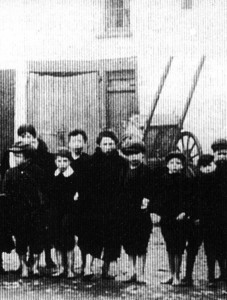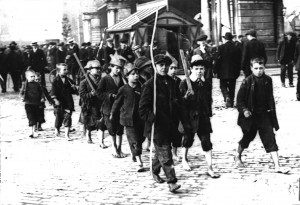
- Front cover of James Curry’s book Mercier Books Price €11.69
Who was Ernest Kavanagh and why was he significant in the era of the Lockout?
Ernest Kavanagh was an insurance clerk who worked for the Irish Transport and General Workers’ Union (ITGWU) in the four years or so prior to his fatal shooting on the front steps of Liberty Hall during the Easter Rising. He was a civilian casualty rather than a combatant, and his significance lies in the fact that he also happened to be an important cartoonist. Most of Kavanagh’s illustrations appeared in the ITGWU’s weekly paper, The Irish Worker, which was edited by James Larkin, apparently a good friend of his. Yet Kavanagh also contributed cartoons to other nationalist and suffrage papers from the period such as Fianna, Irish Freedom and The Irish Citizen. James Connolly, Seán O’Casey and Countess Markievicz were among those who admired his work. (more…)
Padraig Yeates on March 18, 2012 | Filed Under Uncategorized | Comments Off on Interview with James Curry on his biography of Ernest Kavagh
A 1913 Committee has been set up to commemorate the Great Lockout and the crucial events of that year in Dun Laoghaire and the surrounding district. These include the death on hunger and thirst strike of Irish Transport and General Workers Union branch secretary James Byrne, in protest at his imprisonment for union activities and the controversial events surrounding the ‘kidnapping’ of strikers children. John Douglas, President of the ICTU and General Secretary of Mandate, is the Chairman. Anyone interested in becoming involved should contact the Secretary, Davnet Cotter, at davcotter@ireland.com or the PRO, William Byrne, at williambyrnemusicnews@ireland.com.
Padraig Yeates on March 16, 2012 | Filed Under Uncategorized | Comments Off on Dun Laoghaire Committee set up to commemorate 1913
Two UCD students Aoife O’Neill and Michael Smalle recently completed an extended interview with Padraig Yeates, author of Lockout: Dublin 1913, which has now gone viral (in the nicest possible way). The full audio version is on
http://soundcloud.com/the-1913-lockout
The edited Video Chapters are on
http://www.youtube.com/user/lockoutwiki
Padraig Yeates on November 29, 2011 | Filed Under Uncategorized | Comments Off on Extended Interview with Lockout author
Ceantar Mhaighneann
The Kilmainham and Inchicore Heritage Group
The Kilmainham and Inchicore Heritage Group unveiled two plaques to Labour pioneers at the old ITGWU premises, ‘Emmet Hall’ at 122 Emmet Road, Inchicore, on Friday 4th November (more…)
Padraig Yeates on November 5, 2011 | Filed Under History | Comments Off on Two Pioneers of Labour movement remembered in Inchicore
One hundred years ago, and two years before the 1913 Lockout, the district of East Wall had a taste of the battle to come from its youngest citizens. Local Historian and Community activist Joe Mooney tells a story rescued from a school’s lost archive. (more…)
Padraig Yeates on September 13, 2011 | Filed Under History | Comments Off on A Revolutionary Rehearsal in Dublin’s East Wall ?
Ex-employee of Award-Winning Poppadom Restaurant still waiting to be paid €86,000 award
Muhammad Younis, originally from Pakistan, has been awarded €86,000 by a Rights Commissioner, following an official complaint about alleged breaches of employment rights. However Mr Younis’ex-employer, Mr Amjad Hussein trading as Poppadom, has not yet paid the award. The Labour Court yesterday (September 12th, 2011) ordered Mr Hussein to pay the compensation.
Muhammad Younis worked for Mr Hussain for seven years from 2002-2009. He was paid well below minimum wage and worked extremely long hours (77 hours per week) with no day off. He was forced to work without a contract of employment, no tax, or social insurance contributions being made, and was subjected to threats. The employer also failed to renew Muhammad’s work permit which rendered him undocumented in the State. He was forced to share a house with nine other workers in very poor conditions. He had to endure these degrading conditions for many years. (more…)
Padraig Yeates on September 13, 2011 | Filed Under Industrial Relations | Comments Off on Forced labour in Ireland too?

United We Stand!
School strike in East Wall remembered 100 years since school boy strike of 1911
This year marks the 100th anniversary of the East Wall school boys strike. On 13th September 1911, teachers arriving at the East Wall Wharf National School found a message chalked on the door, “Any boy cot going into school and not following other schoolboys examples will be killed by order Strike Strike Strike”. Pickets were placed in the vicinity of the school, and boys paraded around carrying flags with their demands. These included “shorter hours, cheaper books and an end to canings”. The strike was to continue for three days, with pupils attempting to enter the school being branded as scabs and pelted with stones and cabbage stalks. The age of those involved was between 8 and 13 years old. (more…)
Padraig Yeates on September 12, 2011 | Filed Under History | Comments Off on Dublin’s East wall celebrates Centenary of 1911 School Strike
-

-
Ella Burke’s ‘The Bump’ at the Joinery Gallery, Arbour Hill, Dublin. Obviously hoping for a soft landing
This exhibition is on from August 17th to 22ns at the Joinery, Arbour Hill, Dublin. The easiest way there by public transport is the Luas Red Line to the Museum stop. Walk up through the Collins’ Barracks complex and turn right onto Arbour Hill. It’s next door to a small coffee bar just past the turn for Ard Righ Road. To be honest I found the commentaries written by these young artists for the Catalogue more interesting than the exhibits as an indication of future work. But then as a graphically challenged pensioner, what would I know? You can also see the exhibits and read the commentaries on www.thejoinery.org
Padraig Yeates on August 18, 2011 | Filed Under Art | Comments Off on The Bump, London Riots and much else…
Paul Dillon charts the history of the Irish Worker
In the first issue of the Irish Worker and People’s Advocate in 1911, its editor James Larkin wrote: “Too long, aye! Far too long, have we, the Irish working people been humble and inarticulate. The Irish working class are beginning to awaken. They are coming to realise the truth of the old saying ‘he who would be free must strike the blow’.” (more…)
sfmillar on July 17, 2011 | Filed Under History | Comments Off on “He who would be free must strike the blow”
 Eurofound research presented at a recent seminar in the European Parliament estimated the cost of excluding young people from the labour market at over €100 billion across 21 Member States in 2009.
Eurofound research presented at a recent seminar in the European Parliament estimated the cost of excluding young people from the labour market at over €100 billion across 21 Member States in 2009.
The issue of young people (aged between 16 and 24 years) who are not in education, employment or training (the so-called ‘NEETs’) has been extensively debated. However it is rarely costed on an EU scale. Eurofound calculations take account of social welfare payments, the potential contributions to gross national product (GNP) that these young people are unable to make and puts a preliminary figure on the cost to society of €14,000 per NEET, of which €11,000 represents unpaid contributions and €3,000 represents benefits payments.
http://www.eurofound.europa.eu/press/eurofoundnews/2011/july/newsletter2.htm?utm_source=july2011&utm_medium=email&utm_campaign=eurofoundnews
Padraig Yeates on July 14, 2011 | Filed Under Uncategorized | Comments Off on €100 billion is cost of Youth Unemployment across 21 EU states




 Eurofound research presented at a recent seminar in the European Parliament estimated the cost of excluding young people from the labour market at over €100 billion across 21 Member States in 2009.
Eurofound research presented at a recent seminar in the European Parliament estimated the cost of excluding young people from the labour market at over €100 billion across 21 Member States in 2009.